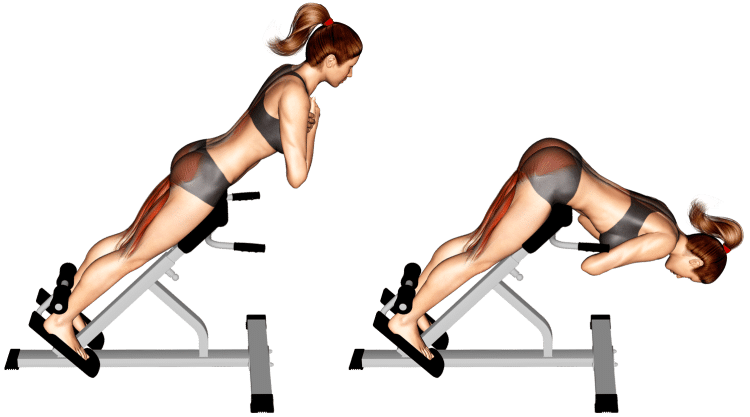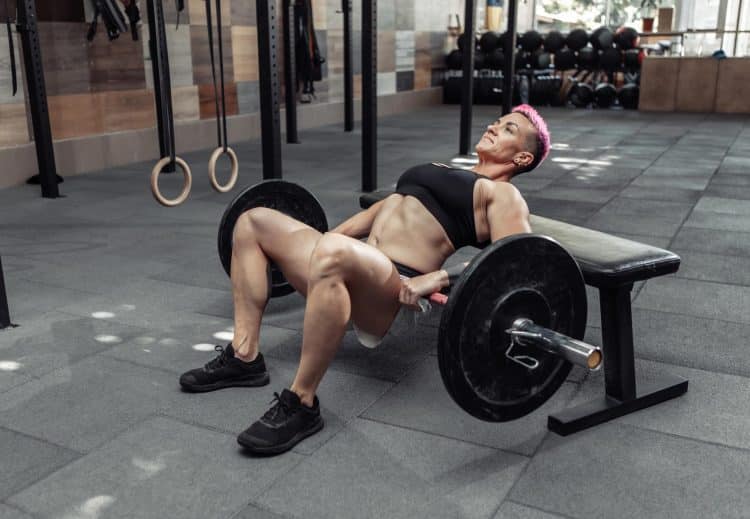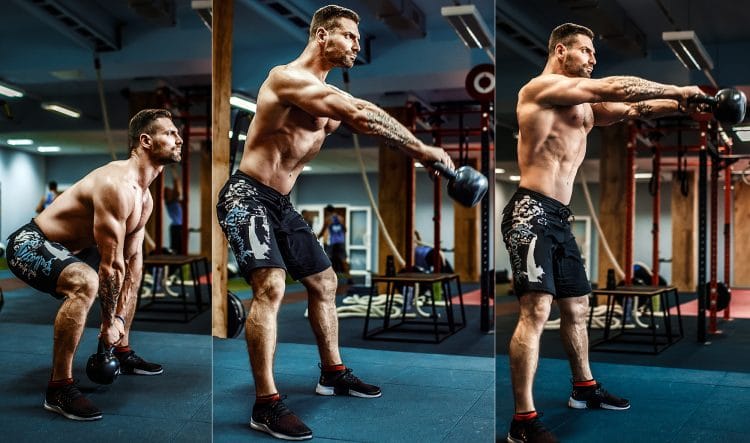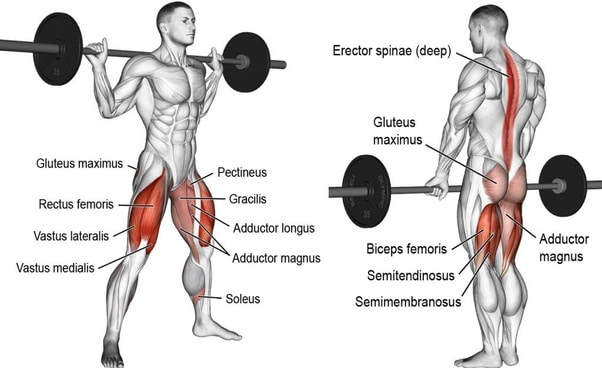A big, strong back is what everyone’s after, and while rows, deads, and pulls make the cut in everyone’s workout regime, less popular but necessary exercises like 45-degree hyperextensions (also known as back extensions) oftentimes don’t. But truth be told, it can have a big impact on your lower, middle, and upper, back, glutes, and hamstrings too.
As we also mentioned later on in this article, fitness competitors know the importance of hyperextensions because it’s one exercise that helps bring up your lower back muscularity. It’s a potent and underused movement.
In this guide, you’ll learn the ins and outs of hyperextensions, also known as back extensions, like how to use your hips on the pads, benefits, sets, and reps, and which variations work best.
This Exercise
- Target Muscle Group/s: Erector spinae, gluteus maximus, hamstrings
- Type: Strength, hypertrophy
- Mechanics: Isolation
- Equipment: Roman chair/acceptable alternative
- Difficulty: Intermediate
How To Do 45-Degree Hyperextensions
45 degree hyperextensions are a unique movement in that you can choose which muscles to target by modifying your technique. Below are written instructions and a video tutorial that walk you through the different variations of this exercise.
Step 1 – The setup
First get properly set up on a Roman chair by adjusting it to your body. The top of the bench should be below the top of your pelvis bone, which will allow your hips to move freely so you can hinge at your hips, and not round at your back.
Step 2 – Body position
Lean into the bench, keeping your body straight, and head neutral. Your feet should be roughly hip width apart and parallel to each other.
Step 3 – Hip flexion and torso angle
Bend at the hips and lower your upper body toward the ground. Your core muscles should tense to stiffen your spine and keep your back completely straight. Stop when your torso is slightly below parallel to the floor.
Step 4 – Hip extension using glutes, hamstrings, and toes
Extend your hips while squeezing your glutes, and pressing your toes into the platform, until you’re back to the starting position. Repeat as many times as needed.
Watch the Video tutorial
Check out the video demonstration for key form tips or simply refer to the written instructions and tips in this guide to ensure you’re maximizing your 45-degree hyperextensions.
Related: Best Roman Chair Hyperextension Machines Reviewed For 2022
Tips
- The movement should occur at the hips, and not by rounding your back. It’s all about proper pad height.
- Make sure to squeeze your glutes and press with your toes during back extensions.
- Start with your body weight only, get good at the movement, and then add weight once you can perform 15 solid reps!
- When you’re ready to progress, simply hold a weight in hand, or wrap a band around your waist to increase the load. You don’t have to but if you’re training goals are to increase strength, then it’s a good strategy.
- You can also use a Glute Ham Developer (GHD) bench which allows you to perform a similar movement and train all of the same muscles.
Muscles Worked
45-degree hyperextensions are a powerhouse that collects input from several muscles in your rear! Learn about the anatomy of muscles that benefit from this exercise below.

Erector spinae
Referring to the muscles that line your spinal column on either side. As the name suggests, erector spinae help us to stand upright from a bent over angle. Hyperextensions rely on these muscles heavily to complete each repetition.
Gluteus maximus
An absolute titan on your backside, the gluteus maximus creates the most volume, size and shape on your butt and hips. Aside from looking good back there, your glutes assist in maintaining an upright posture, and help extend the hips like when you squat, jump, and stand up.
Hamstrings
A significant thigh muscle, your hamstrings stretch from the hip to the knee joint on the rear upper leg. Composed of three heads, your hams work together to bend the knee, extend the hips, and rotate your hip joint.
Benefits
Hyperextensions are anything but flashy, but make no mistake, they’re heavy with the benefits. Here’s why we recommend this old-school movement.
Build a savage posterior
Hyperextensions, especially loaded heavy, are often utilized by bodybuilders who need more muscle and detail in their lower back. But you also have to use the glutes, and hamstrings. In fact, you can shift the focus to emphasize either the lower back or leg muscles.
Increase back stability and posture
The erector spinae muscles help straighten and rotate the back, therefore, making them stronger is going to support everything that you do physically. Hyperextensions are also something you can do to help improve and maintain healthy posture, which is incredibly important, especially now with our heads constantly buried in our electronic devices.
May help to reduce lower back pain
An uncooperative lower back that aches is often the result of, well, weak lower back muscles. Training your core with hyperextensions, and the staple compound moves, will always improve, or even eliminate a sore lower back. If think about it your poor lower back is placed under a lot of stress, especially during things like squats and deadlifts. Not to mention, if you don’t use your core, and then jump into physical labor or activities, you’ll be feeling it!
Read: Lower Back Pain: Common Causes and Prevention For Athletes
Common Mistakes When Performing 45-Degree Hyperextensions
Know that 45-degree hyperextensions are there to improve your body, but you should still be cautious due to the nature of their position.
Wrong hip pad height
Hyperextensions are a hip hinge movement, but if you adjust the pad too high, you’ll be doing more of a crunch. And rounding your back too much, especially under heavy weight loads, is not recommended. As we explained in the exercise instructions, the hip pad should be below the top of the pelvis bone, giving your hips adequate movement. The videos tutorial in this guide show proper examples of ideal pad height.
Using too much back
45-degree hyperextensions are not a stretching exercise. Therefore, there should be minimal to no back rounding. Use your core to stiffen your spine, keep your back completely straight, and focus on hinging at the hips to initiate the movement.
Using momentum
It’s way too tempting to want to use momentum, and swing your way through each rep. Not only are you increasing the risk of injury, but there’s no way the target muscles are benefitting as much as they could be.
Variations and Alternatives of 45-Degree Hyperextensions
We have to admit, this is a pretty sweet list of the variations and alternatives that you can do in place of 45-degree hyperextensions. There may be a lot of difference between some of these exercises, but each one has its advantages.
Reverse hyperextensions
In the 45-degree hyperextension, your upper body is the load. In a reverse hyperextension, it’s your legs. There are also machines that allow you to do the reverse variation. However, there’s a disadvantage to this variation in that it doesn’t involve the same degree of involvement from the erector spinae muscles.
Deadlift

Many would crown deadlifts as the king of all exercises, and it’d be justified. Working every muscle in the body from head to toe (not an exaggeration either), deads are a raw, unadulterated lift, and there’s a reason it’s one of the three powerlifts, and so well respected in strength sports.
But you can also opt for the Romanian deadlift (excellent choice), cable deadlifts, rack pulls, or any of the other common variations.
Rack pull

Best reserved for more experienced lifters, rack pulls are a deadlift variation but with the bar and weights raised several inches off the ground, like on a power rack, blocks, Smith machine, etc.
The selling point for rack pulls are that the legs are not as involved (but still involved) compared to a deadlift. So, mentally, more of the focus shifts to your upper body. It’s a great way to overload your erector spinae, and improve hip hinge strength.
Hip thrusts
While it’s more of a butt focused exercise, hip thrusts are a ridiculous movement for attracting muscle, and massive on strength in your rear end. It’ll also help fortify your lower, middle, and upper body too. Hip thrusts should be in your gains cabinet without exception.

Steps
- Sit on the floor and place your back against a flat bench or an object of similar height and construction. Extend your legs straight with your feet roughly shoulder-width apart.
- Roll a barbell up to your hips.
- Grab the bar with a shoulder-wide overhand grip.
- Then bend your knees and plant your feet flat on the floor.
- Now brace your core and squeeze your glutes.
- Lift your hips towards the ceiling by driving your feet into the floor until your body is in a straight line from your head to your knees. Your lower legs should be perpendicular to the floor at this position.
- Pause and contract your glutes at the top.
- Slowly return to the starting position and repeat for the desired number of reps.
Kettlebell swing
One of the ultimate functional movements, kettlebell swings are a common CrossFit activity with benefits beyond a strong and more aesthetic body. Involving triple joint (hips, knees, and ankles) extension, kettlebell swings copy athletic movements, and require a lot of energy, priming your body to torch fat cells!
Plus there’s nothing like giving yourself a break from the boring routine, and challenging yourself.

Steps
- Place the kettlebell on the floor in front of you.
- Keep your feet slightly wider than hip-width and bend your knees a quarter of the way.
- Tighten your core, keep your shoulders down, straighten your back, then hinge forward at the hips without bending your knees further. Grip the kettlebell with two hands.
- With your torso parallel to the floor, flex your lats and lock in your rear delts. Keep your arms close to your body.
- Swing the kettlebell back between your legs then thrust your hips forward into the standing position which should move your arms upward in front of you.
Cable pull throughs
You can replicate hypers, and kettlebell swings using cables. Simply attach a double ended rope to the lowest position on the machine, face away from it, and do the same thing to activate your back, glutes, and hamstrings.

Steps
- Attach a rope handle to a low pulley machine. Stand with your back to the weight stack, feet roughly hip width apart.
- Tense your core, pull your shoulders back and down, then bend down and grab the handle with both hands between your legs. Stand up and take a couple of steps forward to create tension in the cable.
- Your feet should be roughly shoulder-width apart, knees slightly bent, hands in front of your hips. This is your starting position.
- Push your hips back and lean forward until you feel a deep stretch in your hamstrings. Maintain a neutral spine throughout, including your upper back and neck.
- Drive your hips forward and stand back up.
- Hinge forward again and repeat.
Related: 7 Best Rack Pull Alternatives for Muscular Back
Good mornings
A lower back focused exercise that is the subject of much debate, when done right, good mornings can be beneficial and effective. Proper technique cannot be stressed enough and fail to do good mornings safely, especially using heavy weights can mean bad for your spine!
So, while you can find exercise instructions below, we do recommend you check out our full good mornings exercise guide for more detailed training tips and information.

Steps
- Place a barbell in a squat or power rack just below shoulder-height. Duck your head under the bar and stand up so that it’s resting on the middle of your traps muscles. Grasp the bar with a slightly wider than shoulder-width grip.
- Unrack the barbell and step back to give yourself room to perform the exercise. Stand with your feet hip to shoulder-width apart. Bend your knees slightly and brace your core.
- Hinging from your hips, push your butt back and lean your torso forward while keeping the knees slightly bent. Do NOT let your lower back round. Your range of motion will depend on your hamstring flexibility. Do not lower the bar below the level of your hips.
- Drive your hips forward and stand back up.
Also try these Hyperextension Alternatives for A Powerful Posterior Chain.
FAQs
What are the best sets and reps for 45-degree hyperextensions?
It all depends on your level of training experience, form, and goals.
For example, while some exercisers may choose to load hyperextensions with additional weight, that may never be the goal or necessary for someone else.
Can you perform this exercise while holding dumbbells without rounding your spine? If so, then weighted back extensions can work for you.
For beginners, two set is adequate, but more advanced trainees may need four.
Typically, 2-4 sets to failure, or 6-15 reps is a good range for most people.
More advanced gym goers are better able to prescribe a more precise sets and reps range.
How far down should I go during 45-degree hyperextensions?
It’s a bit subjective. Honestly, there’s no one perfect way for everyone. However, you should be able to bend your upper body without rounding your back. Although, this is more dangerous when using additional weight.
Wrapping Up
If you’re ready to sling 45-degree hyperextensions into your workout regime, you won’t be disappointed. There aren’t many ways to do the same thing with just your body weight, hence why companies make Roman chairs specifically for this exercise. But there are other methods to accomplish the same thing. Such as using a GHD machine, doing deadlift variations, or swinging around the medieval kettlebell.
